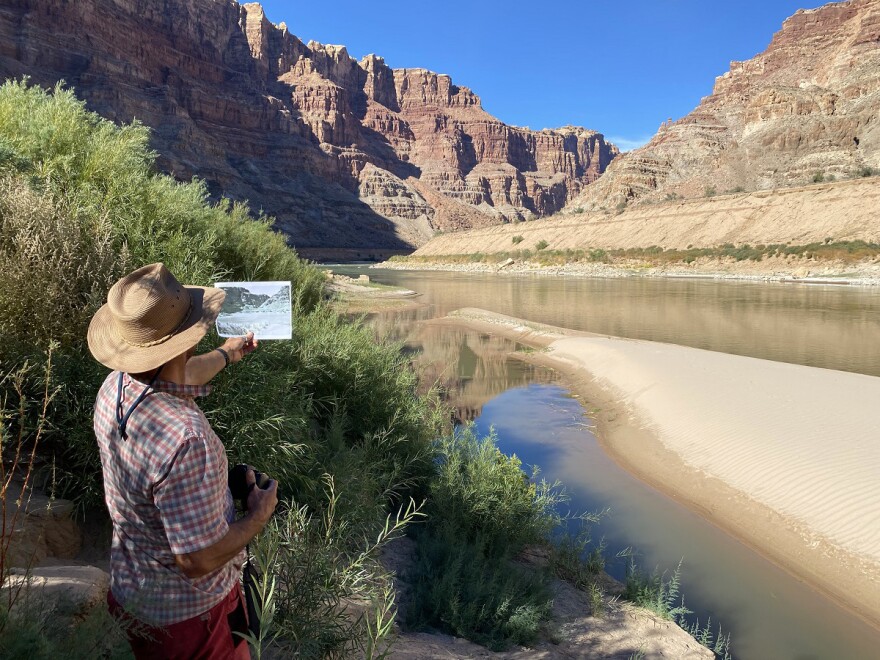On the lower portion of Cataract Canyon, river runner Pete Lefebvre navigates a boat through Rapid 29 aka ‘The Chute.’ This video, taken in 2015, shows a dynamic river, giant muddy waves are toppling over the boat and Lefebvre’s passengers are gripping its side.
When the reservoir was full, this churning wave train was completely still—buried under the flatwater of Lake Powell. But now the reservoir is receding because of overuse and climate change. Water managers worry, but river runners rejoice.
“There are rapids down there that are not on any published river map right now. They're coming back at a rate that publication can’t keep up with.”
That’s lifelong Moab-based rafter Mike DeHoff. He and Lefebvre spend every chance they get on this section of the Colorado. And about three years ago, they started comparing notes, swapping stories after their guiding trips, and wondering:
“When’s the next rapid gonna come out? I'm curious about that,” DeHoff said. “I want to see where it is.”
So they started investigating. First by taking pictures of the changes, like rocks just beginning to poke out of the surface of the water, modifying the river’s character. The pair draws similarities to “Chasing Ice,” a 2012 film that documented shrinking glaciers. DeHoff said they started taking photos and comparing them to historical ones.
“The great thing about it is, it's a real live treasure hunt and kind of terra incognito every year,” DeHoff said.
DeHoff and Lefebvre matched a 1921 photo from a survey of the Colorado River. The picture shows a boat running through a dynamic stretch of Lower Cataract, where today you would observe mostly flatwater. But Lefebvre said there’s a little character coming back.
“Yeah, it started with just like a little ripple in the water to the surface,” Lefebvre said. ”And then another rock was sticking out and then eventually you start seeing this thing turn into a riffle.”
They’ve named the area La Rue’s Riffle, for the photographer who took that photo nearly a century ago and added it to their own river map as part of their online project– Returning Rapids of Cataract Canyon.
It’s not just river guides getting excited. Their citizen science work has attracted researchers, and Colorado River decision makers.
“The greatest value of what Mike DeHoff and Pete and others are doing in the Returning Rapids Project is that they're collecting the basic data that gives people pause, to say, there's a benefit and a cost to everything we do about the Colorado River,” said Utah State University professor Jack Schmidt, who leads the Center for Colorado River Studies.
This Fall, Schmidt joined other academics and researchers on a trip through the canyon with DeHoff and Lefebvre. Schmidt said Cataract Canyon is becoming the place to study what happens to an ecosystem when a reservoir recedes. So Lefebvre said it’s not just about new thrills for rafters.
“We’re getting all this character back with rapids, beaches, current, eddies, animal life, and native vegetation,” Lefebvre said.
Negotiations on a new set of guidelines for the Colorado River’s management are set to begin this year. Who is at the table for those talks is still in flux. And Schmidt said river recreators have been and will continue to be powerful players in the basin.
“They have the potential to change the debate,” Schmidt said. “And it reminds us that boatmen have a tremendous stake and a tremendous potential influence, because they know and care about the resource so much and it really needs to be celebrated.”
This story is part of ongoing coverage of the Colorado River, produced by KZMU in Moab, Utah in partnership with KUNC in Colorado, with support from the Walton Family Foundation.
Thanks to Molly Marcello from KZMU in Moab for covering this story. Visit kzmu.org for more of her coverage.


